Updated 7.22.24: A few updated reviews (marked) and two new tonic waters: Trader Joe’s, and Franklin & Sons.
We’ve all seen expensive tonic waters in the grocery store, but are they worth the price?
Over the years many people have asked me what are the best tonic waters, and if they are worth the cost. Last week I sat down with groups of hardy tasters to compare as many tonic waters as possible. All were tasted with plain soda and then with gin and soda from a siphon. It should be noted, that some tonics may go quite well with gin, but not with vodka and vice versa.
One problem with rating anything is that taste is subjective. I may like something bitter and floral, but you may prefer smooth citrus flavors. These days, there seems to be a trend away from the flavor of cinchona (quinine), possibly amid claims that many companies do not practice sustainable harvesting. Using our tasting notes, pick the characteristics that are most important to you. Some of them are rather expensive so you may wish to throw price into your equation. You can use our list at the bottom of this page to see our ratings.
Included in this roundup are & Tonic, Betty Buzz Tonic, Bradley’s Kina Tonic, East Imperial Tonic, East Imperial Old World Tonic, Fentimans Traditional, Fever-Tree Premium, Fever-Tree Naturally Light, Franklin & Son’s, Harry’s Ciprani Indian Tonic, our homemade tonic, Jack Rudy Cocktail Company Classic Syrup, John’s Premium Tonic Syrup, La Nostra Acqua Tonica Di Chinotto, Liber Tonic Syrup, Llanllyr Source, Never Clear, Portland Syrups Rose City Tonic, Q Spectacular Tonic water, Sanpellegrino Tonica, Schweppes Tonic Water, Sea Buck Tonic Cornwall, Trader Joes, and Whole Foods Tonic Water.
& Tonic Co.
I hadn’t heard of “& Tonic” until they contacted me asking if I planned to include them in my roundup. It can be found in many Portland liquor stores/distilleries, so I picked some up to try. I’m glad I did.
Ingredients: water, cane sugar, citric acid, cinchona bark, and essence of citrus, spices.
Notes: From Seattle Washington. Since I had quite a few new tonics, I got the tasting crew together for a socially distant tasting. It vaulted to the top five of our rankings (see below). The only thing that kept this tonic from placing higher is that it was a bit too sweet for most of us and it needs a bit more cinchona; I’d call it a mildly flavored tonic. However, that made it a perfect refresher for sipping with soda water, but it didn’t stand up quite as well with Gin. Still, I would reach for this on the shelf without hesitation. The flavor is balanced, with citrus and a hint of spice making for a light, summery drink. There is an expected slight pithy sharpness from the quinine and citrus, specifically lemon and orange, as well as a nice amount of cinchona which all carry across the palate. & Tonic has a slight fizz on the tongue beyond what the soda water brings. In our blind tasting, more than a few people gave off a surprised, “Oh, wow” in a good way.
Cost: I got an 8 oz. bottle for about $15, which will make approximately 16 cocktails. (corrected qty)
Betty Buzz Tonic
 Betty Buzz is a relatively new tonic in our local stores. The company advertises the tonic as using only clean ingredients(?), real juice, natural flavors, natural sweeteners, vegan-friendly, kosher, crafted in the USA, no artificial flavors, no artificial sweeteners, no artificial colors, Gluten-free, and non-GMO. The only thing they left out is organic. From the manufacturer, “Betty Buzz is a new line of flavored sparkling beverages that are just as cute as they are delicious. These lovely drinks are intended to be enjoyed on their own — as non-alcoholic party-sipping alternatives — or they can be used as mixers for the perfectly balanced cocktail.” That PR line doesn’t exactly inspire confidence.
Betty Buzz is a relatively new tonic in our local stores. The company advertises the tonic as using only clean ingredients(?), real juice, natural flavors, natural sweeteners, vegan-friendly, kosher, crafted in the USA, no artificial flavors, no artificial sweeteners, no artificial colors, Gluten-free, and non-GMO. The only thing they left out is organic. From the manufacturer, “Betty Buzz is a new line of flavored sparkling beverages that are just as cute as they are delicious. These lovely drinks are intended to be enjoyed on their own — as non-alcoholic party-sipping alternatives — or they can be used as mixers for the perfectly balanced cocktail.” That PR line doesn’t exactly inspire confidence.
Ingredients: carbonated water, agave syrup, citric acid, “quinine and other natural flavors.”
Notes: Very large energetic bubbles. Is it just our tasters, or do people just want banal tonic water that they can drink with or without alcohol. Like many of the newest tonics, we have tried this one could never stand up to a good gin. We found it refreshing to drink on its own, but it got lost in the gin, and none of us would buy it again for other than a vodka tonic. Not recommended.
Cost: .22 per oz. or $2.00 a bottle.
Bradley’s Kina Tonic
Ingredients: water, sugar, spice, citric acid, orange peel
Notes: All of us liked the Kina Tonic, and it rated #2 in our October 2020 testing. This is another Seattle-made tonic syrup, meaning it will need to be paired with good club soda. Kina is terrific. Light nose. On the initial taste, the spices bloom wintery and smooth. It has a slight pithiness that is rounded off by the sugar and enough bark to balance things out, though we’d like a little more cinchona. An unexpected caramelized flavor on the finish is pleasant. Kina ties with & Tonic for our favorite mixer without gin.
Cost: The concentrate is $13 for 8 oz, which will give you 8-10 cocktails.
%27%20fill-opacity%3D%27.5%27%3E%3Cellipse%20fill%3D%22%23fff%22%20fill-opacity%3D%22.5%22%20rx%3D%221%22%20ry%3D%221%22%20transform%3D%22rotate(104.4%2084.8%2073)%20scale(83.71033%20205.76501)%22%2F%3E%3Cellipse%20fill%3D%22%233b0004%22%20fill-opacity%3D%22.5%22%20rx%3D%221%22%20ry%3D%221%22%20transform%3D%22matrix(4.62578%20-182.52222%2082.0014%202.07822%20128.7%20443.2)%22%2F%3E%3Cpath%20fill%3D%22%23cddcda%22%20fill-opacity%3D%22.5%22%20d%3D%22M302.7%20218.3l15.6%20297.3L234%20520l-15.6-297.3z%22%2F%3E%3Cellipse%20fill%3D%22%23fff%22%20fill-opacity%3D%22.5%22%20rx%3D%221%22%20ry%3D%221%22%20transform%3D%22matrix(-195.41802%20-63.30165%2020.36686%20-62.87436%20205.9%201.2)%22%2F%3E%3C%2Fg%3E%3C%2Fsvg%3E) East Imperial Tonic Water
East Imperial Tonic Water
Ingredients: Water, Cane Sugar, Citric Acid, Hand Selected Natural Quinine From Java Cinchona Bark, and Natural Flavors (Herbs & Extracts).
Notes: According to the manufacturer, this tonic water “is created to have a bold distinctive taste, so you can recreate the century-old tradition of Long Pink Gins made famous at the Pegu Club in Rangoon, Burma.” The addition of lemongrass and Manao lime gives it a bright, citrus flavor, which you’ll either love or hate. We’d rather add it ourselves as nothing beats fresh lime, and we are controlling types, but in a pinch, if you don’t have citrus, you’ll still get some of that taste. This is decent tonic water, with a bit more cinchona than many brands. I wouldn’t seek it out because it’s too citrusy for my palate, but it’s not a bad option. I’d suggest pairing it with a dry gin.
Cost: $1.80 or $.36 per ounce.
East Imperial “Old World” Tonic Water
Ingredients: Water, cane sugar, citric acid, natural flavors, quinine.
Notes: According to the manufacturer, “East Imperial is now the only tonic water sourcing all of its key ingredients from Asia. This is the Champagne of tonic waters. This is not a soft drink. This is an authentic representation of what tonic water used to be at the turn of the last century before overly sweet tonics became the norm.” I can’t stand this type of copy and have questions. “… all of its key ingredients from Asia”? Why does this matter? The water, which is the #1 ingredient is from New Zealand. They also play games with the ingredient list – citric acid is listed as “acidity regulator.” It goes on, but I will skip to the results.
The Old World version is much drier, and less citrusy than their standard version. Somewhat acerbic, and a bit flat compared to the other version. It has larger bubbles than most. This tonic doesn’t have much going for it, ending in the middle of the tasting range. It’s perfectly fine, but not inspired in any way.
Fentimans Traditional Tonic Water
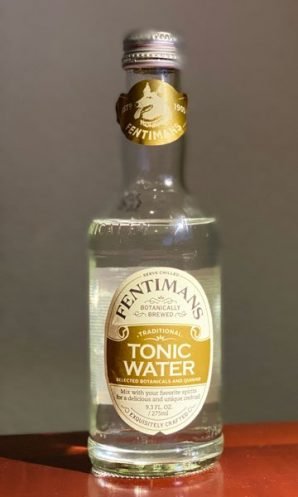 Updated tasting 7.24. For a while, it was next to impossible to find Fentimans in the USA. Now it is available again at various grocery stores. However, the formula seems to have changed, and not for the better.
Updated tasting 7.24. For a while, it was next to impossible to find Fentimans in the USA. Now it is available again at various grocery stores. However, the formula seems to have changed, and not for the better.
Fentimans describe their tonic as “The world’s first botanically brewed tonic water is made with a blend of herbal infusions and lemongrass extract which results in a unique, refreshing and distinctive citrus flavor.”
Ingredients (2020): carbonated water, sugar, citric acid, tonic flavor (water, lemon oil, ethanol, lemongrass oil), quinine.
Ingredients (2021): Carbonated water, beet sugar, glucose syrup, fructose, citric acid, natural flavors, quinine, herbal infusions (juniper berry, kaffir lime leaves), fermented botanical extracts (pear juice concentrate, juniper berry, kaffir lime leaves, lemongrass.)
Fentimans was once a popular tonic water but our tasters never liked it. They seem to be floundering in an attempt to become relevant again. In 2008, it had fewer bubbles than any of the other tonics we tasted and came across as almost flat. They tweaked the Fentimans formula so we tried again in 2018 and found the tonic to be somewhat acrid, with strong herbal, floral notes which didn’t tend to blend well with any of our gins, rather it competed for attention. In 2020 it disappeared from American shelves, but now it’s back with 3 types of sugar and a host of other ingredients like pear juice concentrate. Now it’s even worse. It is very astringent, resulting in a dry mouthfeel. The quinine flavor was muddled and masked; we suspect only enough is used so they can leave it on the label. It goes downhill from there tasting like a cross between Pixie Stix (points if you are old enough to remember them) and preservatives for 13 grams of sugar. The bubbles are back – numerous and very fine to the point where they get in the way. At first, the mouthfeel is all bubbles. Then a strong citrus taste kicks in; it’s overwhelming. Pithy flavors of white rind dominate, though strong bitter orange citrus notes are also present. It finishes with a blast of citric acid and a plastic taste. In short, don’t buy this; it’s awful.
It is also the most expensive of all the standard store brands, and we didn’t feel it was worth the extra cost.
Cost: about $1.75 a bottle – 9.3 oz. 80 calories per serving
Fever-Tree Premium Indian Tonic Water
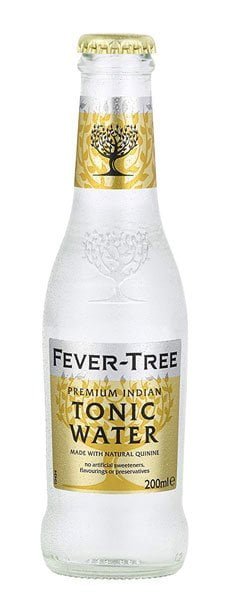 Updated 7.24. Fever-Tree is now making an entire line of tonic waters, most of which I haven’t been able to find here in Oregon. However, we did chase down a couple of them. According to the manufacturer, “The brand name was chosen due to the fever tree being the colloquial name for the cinchona tree, in which quinine, a key ingredient for tonic, is found. The highest quality quinine was sourced from the Rwanda-Congo border and blended with spring water and eight botanical flavors, including rare ingredients such as marigold extracts and a bitter orange from Tanzania. Crucially, no artificial sweeteners, preservatives, or flavorings were added.”
Updated 7.24. Fever-Tree is now making an entire line of tonic waters, most of which I haven’t been able to find here in Oregon. However, we did chase down a couple of them. According to the manufacturer, “The brand name was chosen due to the fever tree being the colloquial name for the cinchona tree, in which quinine, a key ingredient for tonic, is found. The highest quality quinine was sourced from the Rwanda-Congo border and blended with spring water and eight botanical flavors, including rare ingredients such as marigold extracts and a bitter orange from Tanzania. Crucially, no artificial sweeteners, preservatives, or flavorings were added.”
Ingredients: Carbonated Spring Water, Cane Sugar, Citric Acid, Natural Flavors including Quinine
Notes: The aroma and taste are fresh with lots of lemon citrus. It is soft, balanced, and easy to drink by itself. Compared to our first comparisons in 2014, it doesn’t have as much of a quinine taste, the carbonation isn’t nearly as strong as it used to be, and what was there quickly fades, which we found disappointing. What bubbles were there were very fine – all of us loved the mouthfeel. New to this tasting is a higher level of pithiness which leads to a long and slightly unpleasant aftertaste. We felt that the flavor was citrusy but had the expected bitter backend. For those who prefer tonic drinks with lots of citrus and a smooth finish this may be the best choice, but don’t expect a lot of quinine flavor.
Cost: about $0.22/Fl Oz. 66 calories
Fever-Tree Tonic Water – Naturally Light
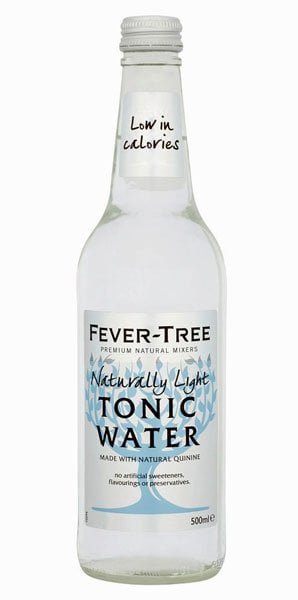 We had a few requests to add this to our tasting panel, so we did. From the manufacturer, “Our Naturally Light Tonic Water is the world’s first all-natural, lower calorie tonic water. With 58% fewer calories, there is no need to compromise on taste as this delicious, crisp tonic water combines fruit sugars and natural quinine with citrus, aromatic botanicals, and soft spring water.”
We had a few requests to add this to our tasting panel, so we did. From the manufacturer, “Our Naturally Light Tonic Water is the world’s first all-natural, lower calorie tonic water. With 58% fewer calories, there is no need to compromise on taste as this delicious, crisp tonic water combines fruit sugars and natural quinine with citrus, aromatic botanicals, and soft spring water.”
Ingredients: Carbonated Spring Water, Pure Fructose (Fruit Sugar), Citric Acid, Natural Flavouring, Quinine
Notes: Fever-Tree claims it has 58% fewer calories than their regular tonic water. From the manufacturer, “Citrus, aromatic botanicals, spring water and a touch of fruit sugar create a fresh, crisp taste balanced by the bitterness of real quinine. Unfortunately, none one of our testers liked it. It is very mild, though we found an unusually bitter aftertaste that was off-putting.
Cost: about $0.22/Fl Oz
Franklin & Son’s Premium Indian
Ingredients: sparkling spring water, sugar, acidifier: citric acid; natural flavours including quinine. Contains no artificial colours, flavours or sweeteners and no preservatives.
From the manufacturer: We only use natural flavours, extracts and colours, and we never include preservatives or sweeteners. Our sparkling water is carbonated to the highest effervescence to bring out the best in spirits. Natural botanical and citrus flavours, sparkling spring water, and the finest cinchona bark extract are blended to make this delicate Premium Indian Tonic Water. Our Premium Indian Tonic Water pairs perfectly well with juniper-heavy gins.
Notes: Despite the description from the maker, we found it flat with limp, insipid bubbles. The maker describes it as “delicate” but tasters in our latest group described it at bland or boring. None of us would buy it.
Harry’s Cipriani Indian Tonic Water
Ingredients: Carbonated water, sugar, citric acid, natural flavor, quinine.
Notes: This joins our list of tonics made outside of the United States, this time from Italy. Medium-sized bubbles. The taste is somewhat weak; it’s difficult to taste much in the way of quinine. Slightly sharp on the palate. Nothing particularly distinguishing, this is a beginner’s tonic and would get lost against robust gin. I wouldn’t buy it again.
Cost: $.28 per ounce. About 6.8 ounces per bottle.
Homemade tonic
Our homemade tonic is a recipe that was originally developed by Portland bartender Kevin Ludwig, who is now at Laurelhurst Market. It was the most complex of all that we tasted. Part of this is because you can add as many ingredients to the recipe as you’d like, so you can balance it with your own taste buds. Overall, it stood tall against the other tonics and balanced well with gin. The flavors were complex and slightly citrus, without being over the top. I am currently working on another, easier-to-make version which is more citrus-forward. Look for it in late July.
Ingredients: water, cane sugar, citric acid, cinchona bark, limes, lemongrass, salt.
Notes: Flavors are going to vary greatly depending on the ingredients you use. Jeffery Morganthaller of Clyde Common switches agave syrup for sugar and adds more types of citrus. Both are good recipes.
I made one batch with cinchona powder that had been sitting around for two years, which was a mistake. Though stored in a sealed bag, the tonic had a slight “dusty” taste and was clobbered by the citric acid. With fresh cinchona bark, it balanced better.
Cost: mostly in the time it takes to make it – inexpensive, but a few hours of on and off work. You’ll find the story of my adventure making tonic from scratch here, along with a recipe. For best results, use a soda siphon for your final cocktail.
Jack Rudy Cocktail Company Classic Tonic
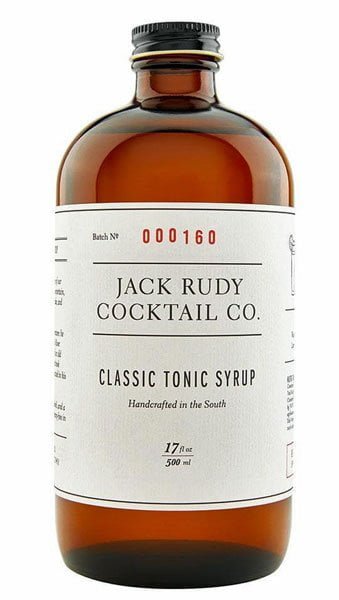 “With a backbone of quinine, culled from the Cinchona Tree, we’ve added a delicate mix of botanicals, and then sweetened it with real cane sugar; the final product is a complex mixture that introduces a fine bitterness to any cocktail, and a great pairing with the botanicals of the finest Gins in the world.”
“With a backbone of quinine, culled from the Cinchona Tree, we’ve added a delicate mix of botanicals, and then sweetened it with real cane sugar; the final product is a complex mixture that introduces a fine bitterness to any cocktail, and a great pairing with the botanicals of the finest Gins in the world.”
Ingredients: Quinine concentrate, water, citric acid, sugar, lemongrass, orange peel.
Notes: This is a small batch tonic concentrate from a company based in Charleston, South Carolina. After reading the story of their founder, I really wanted to like this tonic. But when paired with the recommended amount of club soda, our tasters thought it was overly sweet; this tonic smoothed out the gin so much we couldn’t tell it was there; the quinine taste was completely overwhelmed. This made for a very refreshing citrusy drink with hints of orange and lime along with allspice notes, but not what I am looking for. It’s like Gin & Tonic for beginners. I’m saving the bottle for those times when I just want something light and refreshing.
Cost: $16.00 for 17 ounces of syrup concentrate to be mixed with club soda. ¾ ounces is recommended. It works out to about $0.24/Fl oz. but you’ll need soda water too. 24 calories per serving. You can find a two-pack on Amazon for $26.
John’s Premium Tonic Syrup
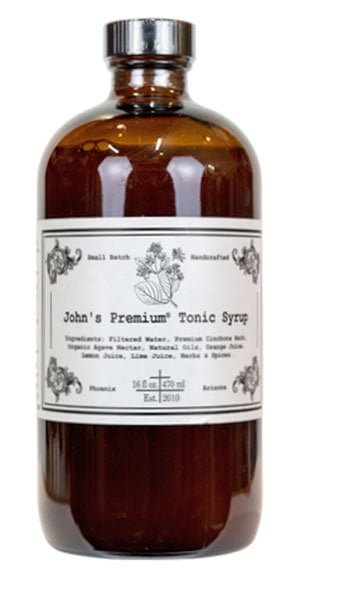 John’s is currently listed on the website as “not currently being sold.” Hopefully, it will return – this concentrate is worth seeking out – the best source I’ve found is the manufacturer’s website. For now, I will leave it on the list.
John’s is currently listed on the website as “not currently being sold.” Hopefully, it will return – this concentrate is worth seeking out – the best source I’ve found is the manufacturer’s website. For now, I will leave it on the list.
Ingredients: Organic Agave Nectar, Cinchona bark, Citric Acid, Natural Oils, herbs, juice, and spices.
Notes: Honey brown tonic with soft agave, earthy notes. Fragrant, bright citrus palate with complex herbal flavors with a slightly sweet note. A good balance of cinchona. This was our favorite of all the commercial tonic mixes, and second only to homemade tonic water. Unfortunately, it is difficult to find, so you may need to order it directly from the source.
Cost: $14 for a 4-ounce bottle including shipping, which works out to eight cocktails. You can get 2, 16oz bottles for $63 including shipping.
La Nostra Acqua Tonica Di Chinotto
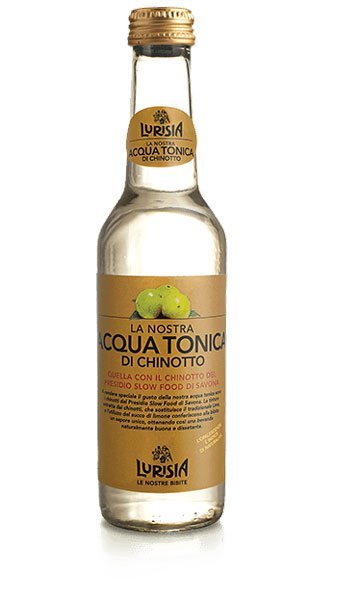 In 2018, I found this tonic at a high-end specialty food store. It’s from Italy and is labeled as “tonic water made from citrus”. From the name, I didn’t expect it to contain quinine, but it does, though not much.
In 2018, I found this tonic at a high-end specialty food store. It’s from Italy and is labeled as “tonic water made from citrus”. From the name, I didn’t expect it to contain quinine, but it does, though not much.
Ingredients: Carbonated Water, Cane Sugar, Lemon Juice, Natural Vegetable Extracts (Infusion of fresh citrus Myrtifolia – Chinotto), and Quinine.
Notes: I was interested because of the use of Myrtifolia, which, if you’ve spent much time in Italy you have probably tried. The common name is the myrtle-leaved orange tree, and the fruit does look like oranges though they are rather bitter. The result is very smooth tonic water with a floral overly sweet finish that reminded me of the 7Up formula from 30 years ago – and it’s reflected in the calorie count. The finish is pleasant and more strongly citrus-flavored than the others in this roundup. I like it as a standalone drink, however, it is completely overpowered by gin.
Cost: $0.67 / Fl oz. 100 calories
Liber Tonic Syrup
Ingredients: water, cane syrup, natural quinine, citric acid, citrus oils, benzoic acid.
Notes: (as of 4/2024 their website is down, but the product is readily available.) We were unimpressed with this clear tonic syrup coming from Austin, Texas. Tasters universally found it unpleasant, and we couldn’t get past a strong chemical taste and nose, which I’m pretty sure is from the unorthodox use of benzoic acid. The final product is unbalanced, overly astringent, and harsh – we don’t recommend it for drinking with just club soda. I’m sure I will find it in the back of the refrigerator in a few months, untouched after our tasting.
Cost: $10 for 9.5 oz. Using their recipe it should make about 12 cocktails.
Llanllyr Source
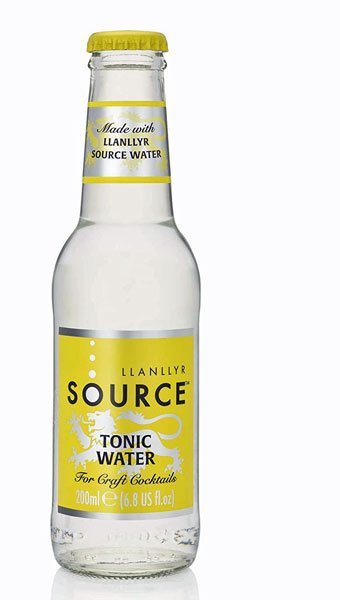 Another 2018 find from an upscale food store, this tonic water is imported from Llanllyr Wales. From the manufacturer, “Since 1180, when the Great Lord Rhys first settled the land, natural springs underneath the organic fields of Llanllyr have been supplying its inhabitants with some of the purest, all-natural drinking water in the world. Llanllyr sits in the idyllic Welsh countryside at the base of a glacial valley. The glacial sands and persistent rainfall work together to produce Llanllyr SOURCE, a Natural Spring Water with a perfect mineral balance and superb taste.”
Another 2018 find from an upscale food store, this tonic water is imported from Llanllyr Wales. From the manufacturer, “Since 1180, when the Great Lord Rhys first settled the land, natural springs underneath the organic fields of Llanllyr have been supplying its inhabitants with some of the purest, all-natural drinking water in the world. Llanllyr sits in the idyllic Welsh countryside at the base of a glacial valley. The glacial sands and persistent rainfall work together to produce Llanllyr SOURCE, a Natural Spring Water with a perfect mineral balance and superb taste.”
Ingredients: Carbonated Spring Water, Pure Sugar, Quinine, Citric Acid, Ascorbic Acid, Sicilian Lemon.
Notes: Though it has a light mild flavor, most of us were bothered by the strong aftertaste of ascorbic acid. The combination of the Sicilian lemon flavor and a plethora of bubbles was strong enough to remind several of us of 7up, and with little bitterness, it was almost as smooth. However, it was overpowered by gin, though you won’t need to add citrus when you make your drink – it has plenty of its own.
Cost: $0.28 /Fl oz. 64.4 calories.
Never Clear Tonic Water Concentrate
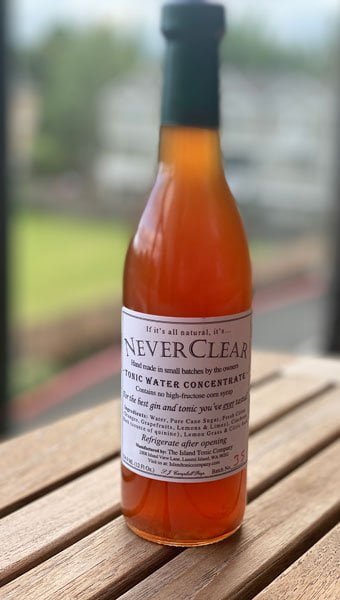 Ingredients: water, pure cane sugar, fresh citrus (oranges, grapefruits, lemons, and limes), cinchona bark, Lemongrass, and citric acid.
Ingredients: water, pure cane sugar, fresh citrus (oranges, grapefruits, lemons, and limes), cinchona bark, Lemongrass, and citric acid.
Notes: We were pretty happy with this tonic at first, but when compared with others in our latest tasting, it dropped down the list a bit. It’s nicely balanced with just the right sweetness but doesn’t lose the cinchona flavor. However, there is an iced tea flavor that bothered the tasters. In a second tasting from another bottle, we found an overly strong cinnamon taste and too much grapefruit pith. It needs a stiff gin, or a heavy pour to properly balance the flavors. Never Clear recommends 2 oz. of gin in a 12 oz glass with ice then filling with soda water, which makes 16 drinks.
Cost: $15 for 12 oz., 40 calories per serving.
Portland Syrups, Rose City Tonic
 Ingredients: water (infused with cinchona bark and dried rose petal), cane sugar, citric acid.
Ingredients: water (infused with cinchona bark and dried rose petal), cane sugar, citric acid.
Notes: This is another concentrate that you mix with seltzer, in this case, 1/4 ounce with 2 oz. of gin. It’s very clean, and refreshing, but with a slightly odd finish that I’m pretty sure comes from the rose petals. Adding a bit more lime than usual helped ameliorate this. The taste was very slightly bitter. Overall, none of us were thrilled – we felt it lacked character. We miss the cinchona flavor which is barely present. The rose notes tasted odd, and we didn’t enjoy the addition. The lack of cinchona means it doesn’t need as much sugar as many tonics, so the calorie count is slightly lower, but I’d prefer more bitterness.
Overall, this would be a good beginner’s tonic, and nice on a hot day when drinking with food, but none of us would buy it again.
Cost: about $16.00 for a 16-ounce bottle which makes about 20 cocktails. 35 calories per serving.
Q Spectacular Tonic Water
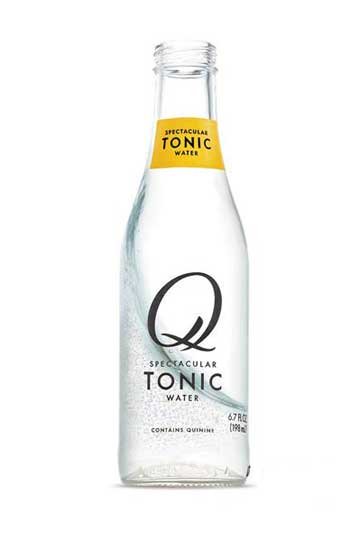 Re-tasted 7.24.
Re-tasted 7.24.
Q Tonic touts that their quinine is hand-picked, that they use organic agave as the sweetener (not my preference), all-natural, and has 60% fewer calories than regular tonic water. Over the past few years, they tweaked the formula and renamed it as “Spectacular” tonic.
Ingredients: carbonated water, organic agave, citric acid, quinine, natural flavors
Notes: In our tasting a few years ago, Q Tonic didn’t do well, with tasters noting a medicinal, slightly astringent taste with a metallic, bitter, and pithy quality. This time the tonic did better, rising to the number one overall choice of the non-syrup, big commercial brands, reminding us of the traditional tonics of years ago. It opens a bit harsh, with juniper overtones. The strong floral citrus notes varied between our tastings, some over the top and other times less pronounced. As it dilutes, the flavors quickly wash out, and the finish is not great. It is an easy-drinking tonic with lots of medium-sized bubbles. However compared with most of the tonics we tasted, it was boring and off-balance. If you like a bitter tonic this this will fill the bill. Overall it stands up to gin just fine. On all four of our tastings over the years a common word was “boring.” Q tonic works well with vodka too.
Cost: about $0.24 Fl oz. 40 calories per serving.
Sanpellegrino Tonica
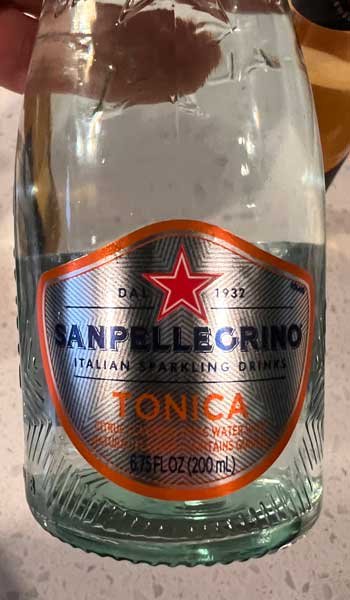 Ingredients: Water, sugar, carbon dioxide, citric acid, natural flavors, quinine.
Ingredients: Water, sugar, carbon dioxide, citric acid, natural flavors, quinine.
Notes: The description on the bottle is “Citrus flavored tonic water with natural flavors.” We were surprised by how little this tonic has to offer. The water is clear. Flavor notes are sweet, mild cinchona – almost an afterthought, and a slightly bitter finish. Our tasting panel agreed that this was one of the most boring in our roundup – bland, unremarkable, forgettable. When used in a gin & tonic it was completely overwhelmed to the point we could barely taste it. I kept adding more and just ended up with a watered-down G&T. No thanks. Final note, it is bottled by Nestle; which gives a clue about the poor quality.
Schweppes
Ingredients: carbonated water, high fructose corn syrup, citric acid, sodium benzoate, quinine, natural flavors.
Notes: Schweppes tonic water has been around longer than just about any other brand. That doesn’t necessarily mean it is good. This drink has more in common with soda than tonic water. It is citrusy but too sweet, completely overwhelming the gin. Most of us didn’t like it alone over ice either. We didn’t try it in a vodka tonic, but it would work better with it. Tasters called it “too fruity”. This goes back to the question, do you want your tonic more traditional with bitter notes, or on the citrusy, floral side?
That being said, it is a good choice for those new to the wonders of a good gin and tonic and a bargain for the price and all of us would buy it in a pinch.
Cost:$0.13/Fl oz. 90 calories per serving
Sea Buck Tonic – Cornwall Premium
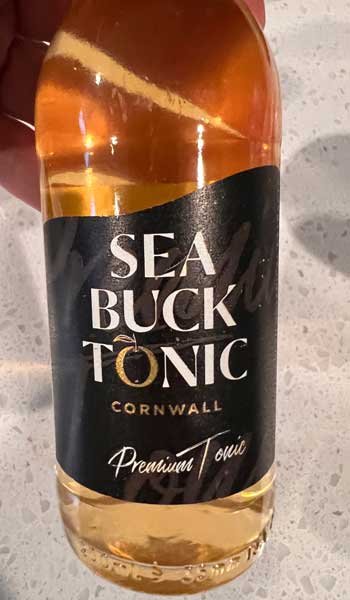 Ingredients: Carbonated Cornish(?) water, sugar, botanical extracts (orange peel, lemon peel, sea buckthorn berries, lemongrass, red cinchona bark.
Ingredients: Carbonated Cornish(?) water, sugar, botanical extracts (orange peel, lemon peel, sea buckthorn berries, lemongrass, red cinchona bark.
Notes: “Hand brewed in St. Ives from natural ingredients.”
I had high hopes for Sea Buck Tonic, as it was stocked by a high-end grocery store that rarely carries anything that isn’t very good. This, unfortunately, is not the case for the Sea Buck. It was pleasant to drink on its own, with a surprising sweetness for tonic water. However, it seemed too weak to stand up to gin. The color is a golden brown. We found it very floral, with fine bubbles, and a mild cinchona bark taste which imparted slight bitter notes. Mixed with Aria Gin, it did nothing but make it taste rather sweet and citrusy; no lime needed. As we expected, when used in a gin & tonic, it smooths the edges so much Sea Buck doesn’t stand up to gin. On the other hand, if you prefer less traditional, much sweeter G&T, this may be a good choice for you. With the sugar comes 163 calories.
Cost: $2.50 for 200ml.
Trader Joe’s
Added 7.2024
Ingredients: Carbonated water, cane sugar, citric acid, natural flavors, quinine. 90 calories per serving.
From the manufacturer: “Trader Joe’s tonic water has been the adventurer’s go-to beverage of choice for centuries. Keeping with tradition, we’ve carefully crafted a tonic water with a touch of natural line flavor, sweetness and just the right amount of bitterness.”
Notes: No one in our latest tasting group particularly liked this. Universal comments revolved around “flat” and “bland”. None of us would buy it.
Whole Foods 365
Ingredients: carbonated water, inverted sugar, citric acid, natural flavors, quinine
Notes: This tonic was discontinued for a while after Amazon bought Whole Foods, but now it’s back. Little seems to have changed; it’s another sweet tonic water, heavy on citrus almost like 7-Up. The overly large-bubbles are annoying. Somewhat bland with no real cinchona flavor; unremarkable tonic water. Perhaps the calorie count at 160 per serving is an indicator of the problem – almost double the other tonic waters in this roundup.
Cost: $.50 per 12-oz can. 140 calories
Overall Ratings:
When we combined the overall scores from each taster, the tonics scored the following, from best to worst.
Homemade – our favorite, but the biggest reason is by making it yourself, it is easy to create exactly the characteristics you are looking for. For this reason, I’m not listing it in the ratings, except to say it always has been at the top of our rankings.
- John’s Premium Tonic
- Bradley’s Kina Tonic (a very close match to & Tonic)
- & Tonic
- Q Spectacular Tonic water
- Fever-Tree
- Llanllyr Source
- La Nostra Acqua Tonic
- Fever-Tree Naturally Light
- Fentimans
- Portland Syrups, Rose City Tonic
- Liber & Co.
- East Imperial Tonic Water
- Schweppes
- Franklin & Sons
- Betty Buzz
- Cipriani Foods
- Jack Rudy Cocktail Company
- Sea Buck Tonic
- Trader Joes
- San Pellegrino Tonica
- Whole Foods 365 Tonic Water
When it comes down to it, the tonic you are going to like depends on your taste and what brand of gin or vodka you mix it with.
The biggest question is whether the boutique versions are worth the price. We think they are, though Q Tonic works in a pinch. I like my homemade tonic recipe, and when I have lots of time and energy, I make it myself. In the end, choose the characteristics that are important to you.
Whatever direction you take, enjoy your drink, and think about this: Tonic water will fluoresce under ultraviolet light. The sensitivity of quinine is such that it will fluoresce in direct sunlight. Make yourself a drink, and go outside to frolic on a sunny day. It’s for science!
Updates
7.7.24 – Update links. Remove one discontinued. Updated Sanpellegrino
4.23.2024 – add East Imperial “Old World” tonic. Update John’s Premium – no longer sold. Update links.
7.15.2023 – add East Imperial tonic water.
7.5.22 Added two new tonics – Betty Buzz, and Cipriani Foods.
12/2021 – Added Sea Buck Tonic, and San Pellegrino Tonics to finish our 2021 tastings. Also re-tasted Fever-Tree and Q Tonic for comparison with no changes.
2/2021 – Whole Foods Tonic Returns
1/2021 – Fentimans is back, but not great.
11/2020 – Removed: Whole Foods and Hansen’s brand have been discontinued.
10/2020 – “& Tonic” syrup, Neverclear, Kina Tonic, and Liber & Co. syrups added. Re-tasted Q Tonic.
6/20 – Whole Foods no longer has a house brand – removed. Fentimans has changed their formula, and at this point, I can’t find it in the US. Whole Foods brand also seems to be discontinued and I’ve removed it. Added Never Clear Brand. More to come!
2/18. We retested all of the tonic waters that had changed from when we first tasted – most of them. In addition, we added two more that have come out since our 2016 tasting. The results of these reviews reflect quite a few changes. Fever-Tree doesn’t have quite as pithy a quality, and Hansen’s isn’t quite as good, so the notes have been updated to reflect that. Overall, prices on the boutique brands have dropped considerably, while the commercial brands have done the opposite. Changes in ingredients, cost, and taste have been noted below. ]
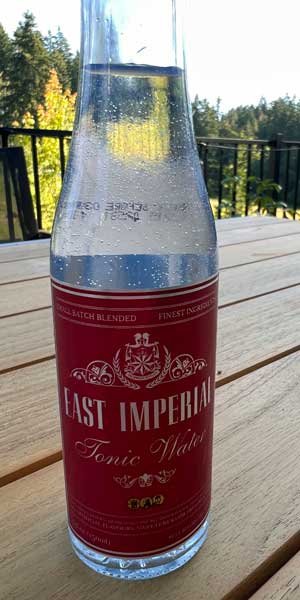
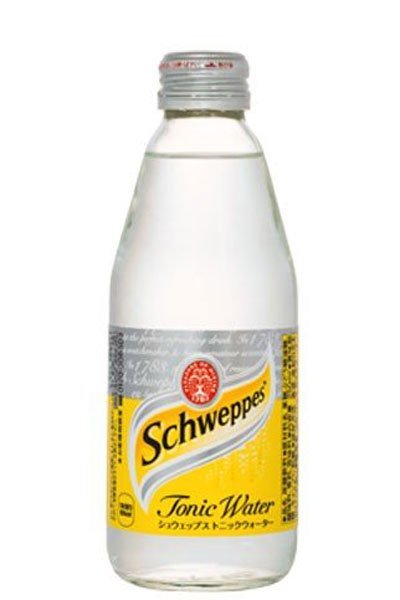
PDX2FLR says
I never thought about corn syrup in tonic waters. Great piece, thanks.
Danny Gross says
If you have never tried our tonic water, you must. Made from the gentian root, providing the cleanest bitter taste ever found in a tonic.
I’ll talk to you after you’ve had the greatest tonic in the world.
Danny
ed frank says
Hello
Thanks for the great article.
What type of gin did you use? Since we are in a gin age, with so many new forms it might be interesting to know what tonic fits best.
One type of tonic water we found in London was a frozen tonic water that tended to dissolve over a few minutes. It was truly interesting.
Ray Gilligan says
Just curious as to why you left out the Canada Dry tonic.
pooh johnston says
agree, best of store brands…. polar is not bad
RestlessLegs says
All of the reviews are based on using the tonic water in a cocktail. If you want to drink just the tonic water due to the quinine for Resless Legs Syndrome (it really works; along with Hylands Restful Legs) – which is the best? Do not want the high fructose corn syrup. Which is the healthiest stand alone tonic water? Thanks for all replies.
Sean Voysey says
I think Jack Rudy is a very respectable sweet drink, but there simply is not enough quinine in it for it be classified as Tonic Water. That being said, I still find it pleasing, but not what I would reach for on a hot summers day.
Jeff Campbell says
I can’t speak to its efficacy as a treatment for restless leg syndrome, but our NeverClear tonic concentrate IS good as a stand-alone beverage, is less sweet than many others, and has a significant quinine content… It also costs less than Jack Rudy, Kina, and all of the other tonic concentrates on the market :)
Linda says
Where can you find it in Texas i cannt seem to find it
Rick Neighbors says
I really enjoyed your article! Good information, especially since I have been planning on investing in a Soda Stream and trying to make my own tonic water for my small bar. Some of these tonics I have never heard of, and some I have never tried. In my bar I use either Schwepps or Canada Dry as a bar tonic, but they are not what I am truly looking for. I also use the Qtonic for myself, but mostly due to the reduced calories and agave nectar which is a low glycemic sweetner that I like. I will read up on your homemade recipe. Thanks.
Andréas Schütz says
Don’t miss the mediterranean version from Fever Tree, lesser sweet and better balance according to me.
Justin says
Awh, I really really enjoy Fentimans tonic.
Soprano2 says
I’ve got to agree with Justin – I think Fentiman’s is the absolute best, after trying them all. Complex and botanical.
Lee Hays says
The best I’ve ever had is the Great Value Diet Tonic Water from Walmart.
PDX Food Dude says
We will add it to the list in our next batch of tastings. Thanks!
Linda says
Does it have Quinn in in it
Windell Cgapman says
Truly Great Tonic at Walmart . I actually prefer the Sugar Free version …not as sweet . Both are great tonics though .
PDX Food Dude says
Which tonic are you referring to?
Amy says
What do you think about El Guapo?
PDX Food Dude says
I’ve never heard of it!
S Jones says
I used to be a fan of Fever Tree massively until i realised that they now spoil it with Fructose, what are they thinking?
I realised the taste was different yesterday so went to the contents, i was horrified to find this awful ‘poison’, that’s the only word i can use i’m afraid…i tipped it down the sink immediately but why did they change it?
For many years i’ve been detoxing from aspartame, sucralese, etc now i am scared that i’ve been drinking similar without knowing so i’d like to know when they added it – was it after the take over…and which company bought them out, can anyone answer that please?
I guess it’s back to water. :*(
PDX Food Dude says
I’ve looked at both the Fever Tree website and picked up a four-pack at the grocery store. They both say “Cane Sugar”. Not sure where you live, but you might want to check again.
Mary Root says
I asked the manager of a local restaurant if I could get “regular” tonic water with my gin, instead of the organic, weird smelling organic crude they offer. He told me that they are looking into a Canadian brand called Fever Tree. This made me chuckle because “‘Fever tree” refers to a tree and its tendency to grow in swampy areas: early European settlers in the region (notably South Africa) noted that malarial fever was contracted in areas with these trees, and stupidly called it such (wikipedia, thank you!!) Addendum: I find it amusing, if not bewildering, that restauranteurs actually choose the origin of the tonic water over the tonic, i.e., the gin, etc., and its “purity,” A restaurant nearby serves only “organic” tonic water, which tastes horrible, and only “organic” chardonnay, from California, of all places. Perhaps, if they want to be preachy and charge higher prices for those who choose to drink alcohol/mixed drinks, they should make sure ALL the booze they serve is “organic” or simply NOT serve most liquors or wines. They would most likely run out of business. What B.S!
Jan Connors says
I always preferred the Hansen’s Diet tonic, but Hansen has stopped making it. I live in a little town, so have to buy what is available at Safeway or Walmart. And, now there is shortage of any diet tonics, in any sizes. I hate buying the big bottles because they always boil over just like I shook the heck out of them. My favorite gins are Tanqueray Rangpur and Hendricks. Thanks for updating your review.
John says
There is something wrong with gins because the tonics are all tastier regardless to the fact that gins once made them palatable seems nonsense to me because straight tonics are delicious yet straight gins give one the taste of burn not Juniper. I think that Bombay Sapphire may be a crummy gin for straight sipping
With tonics the Schweppes is tasty yet the best for drinking are store brand low calorie ones or Fever Tree. The Indian Tonic is not as good as the Mediterranean Tonic or the Elderflower Tonic, and the Aromatic Tonic is also good. The light one is fine although a bit lacking in flavor.
With Fever Tree – The Indian Tonic is most sweet and rather weak. Good for a straight drink if you like a milder tonic although a beginners one in Fever Tree. Move beyond it next
The Light Tonic is a bit saline tasting and also weak. OK for a standalone drink although won’t work in gin or mixers. Even when sipped alone, it could be stronger. It also has a lemony flavor which is good although a good tonic should not be overly citrus powered
The Elderflower Tonic is delicious as a standalone drink although tends to be overpowered by gin or spirits. Good alone or with fruit drinks though. Only use a weak gin or spirit with this one as you will need a lot more to topple it with a strong unsubtle cheap gin like Beefeater or even Bombay Sapphire which is way overrated
The Aromatic Tonic is pink and has a strong quinine punch as well as angostura in it, It has a slight grapefruit flavour. This tonic is very strong and some may find it overpowering although sipped alone its quite tasty, just be prepared for a good punch. It is more sophisticated than the Indian tonic and less for beginners. This tonic is the best one for mixing with gin although not the best one for fruit juice only cocktails where the above ones win
Mike Robinson says
Nice article! At Jeffrey’s Tonic, we’ve actually taken on the challenge and been making recipes inspired by the Morgenthaler early work. They’re not his recipes, but the name is a nod to the great man. The flavours do the name justice and enhance gin pairing like you wouldn’t believe. ?
PDX Food Dude says
Thanks for the comment. Are your tonics available in the US?
Mike Robinson says
Not yet – except for shipping internet orders currently, but we do own the brand in the States. Aaron Knoll’s ‘The Gin Is In’ – https://theginisin.com/tonic-water-review/jeffreys-tonic-syrup/ – had Jeffrey’s Lime, Galangal, and Orange Tonic Syrup win 2018 award for Best Flavored Tonic Syrup.
Jeff Campbell says
Hi all,
I own the Island Tonic Company on Lummi Island in Washington State, and we have been making an all-natural tonic concentrate for the last five years. Distribution is difficult, so we mostly sell through Amazon (look for NeverClear) but it has been very well received, and is, I think, worth a try if you are looking for a better tonic. Aside from not containing ant corn syrup and being all natural, we also donate a significant portion of our proceeds to the Center for Whale Research on San Juan Island. My wife and I are both marine ecologists and started the company to support our passion for Orcas.
Give us a try, I don’t think you’ll be disappointed!
Jeff
John says
Tonic water has an interesting flavour when made properly – it has a bittersweet fruity taste – something akin to the grapefruit or to a bittersweet orange marmalade or bittersweet rindy lemon/lime flavours. The cranberry also has a similar flavour although to a tarter degree even. It should not be too bitter or sweet although the correct cinchona concentration so it is tasty and not too concentrated and bitter when soda water is added to it, meaning it needs little sugar. The artificial grades are the harsh tasting ones that are heavily sweetened. Look for boutique brands at low prices. A refreshing drink to enjoy any time of year and often the summer due to its refreshing taste anyways
PDX Food Dude says
Thanks for your comment!
Ziva says
Any drink that has fructose in it is pure poison to me. Why do they do it?
Why can’t i find a pure tonic water that i can actually drink?
PDX Food Dude says
Many of these don’t have fructose. We’ve listed the ingredients.
sally says
We definitely don’t do the HFCS. The most commercial ones we’ve found with none are Fever Tree and Q Mixers.
Rick Neighbors says
QTonic is my go to tonic for my G&T’s! I like the fact that they use a low glycemic sweetner…..agave nectar…..in their product! I use agave nectar in my hand made margaritas, along with fresh lime juice. I don’t like high fructose drinks, and my body sure doesn’t need them. :) And I really really like the high carbonation content of Qtonic! No one likes a flat drink. I have left an open can of Qtonic out with a bar coaster sitting on top all day, and it is still carbonated!
Jeff Campbell says
I make NeverClear, which has the highest satisfaction rating on Amazon, but can’t get your time of day. I’ve written to you a couple of times, but I seem to be ignored. I’m not great, or amazing, but I do make a decent tonic concentrate.
Maybe one day you’ll ask me for a sample.
Sigh!
Jeff Campbell says
Check it out, no HFCS, and all natural ingredients.
https://www.amazon.com/NeverClear-Tonic-Water-Concentrate-Oz/dp/B06XJ9321Z/ref=sr_1_1?dchild=1&keywords=neverclear&qid=1588044006&sr=8-1
Jeff Campbell says
Unfortunately, we’re a bit small, and haven’t figured out how to make our shopping cart work, so order on Amazon, or at islandtoniccompany@gmail.com
PDX Food Dude says
Thanks for the nudge, Jeff. I’ll order some this week!
sally andrew says
Just a note from me to you, we’ve been ordering Fever Tree and Q tonic waters off amazon.
This vendor has the best price there for Fever Tree: https://smile.amazon.com/gp/product/B07DCJZHS2/ref=ppx_yo_dt_b_asin_title_o01_s01?ie=UTF8&psc=1
and This vendor we just found for Q: https://smile.amazon.com/Drinks-Tonic-Water-Spectacular-Premium/dp/B072N5FNZX?ref_=ast_sto_dp
We enjoy the Aromatic flavor of Fever Tree the best, but flavor is definitely always subjective. My husband and son really like the Elderflower but I do not enjoy it. I like the cucumber, but they definitely don’t.
Have a great day!
Irene Hass says
Interesting post. My friends and I use Schweepes and Canada Dry Tonic for pain and it works. Have been using it for years but, we don’t “drink”. We use it to make iced tea. Yes, it’s sweet but if you make a very week iced tea in a 1/2 gallon container with a whole bottle of tonic and then fill with water and ice, it’s really good. Just saying.
Sally says
Interesting. We aren’t really alcohol drinkers either but I’ve not even thought of mixing it with iced tea. Sounds good! We’ll have to try it.
Trey says
I have read good reviews on El Guapo tonic syrup and that it has a good quinine flavor, based in Louisiana, haven’t tried yet myself. Maybe add that to your list or do one tasting that includes just syrups like El Guapo, Jack Rudy, NeverClear, etc. Our usual go to is Fever Tree, but it’s pricey per drink when not on sale so I was looking at all the syrups to make my own.
PDX Food Dude says
We are always working on adding more tonics. The problem now is getting our group together to keep consistent tasting, but we are working on a solution!
Marty says
Thanks for the interesting article. I’ll throw another angle at you regarding tonic.: I used to live in St. Thomas Virgin Islands. One day I was at an historic bar in Charlotte Amalie on a very hot day and ordered a rum and Coke. The West Indian Man next to me immediately took me to task for my poor taste in drinks and said I should try rum and tonic with lime. He was right!! That has been my go to hot weather drink ever since (45 years). Granted I get strange reactions when I order, but it’s a superb. I spent time checking out tonic at a huge Total Wine store in Florida. So many of the premium brands contained HFCS which I refuse to purchase. A local restaurant in Detroit has been selling house made tonic during the pandemic that is wonderful, but probably only available in house. Based on your recommendation I just ordered John’s syrup. I hope it works with my rum!!
PDX Food Dude says
Thanks for the note. I’ve never tried rum and tonic buy I’ll give it a shot.
Leslye Robinson says
Wow this must be the longest running thread if ever run into. As someone who was a dedicated Tanqueray and tonic drinker IwA interested in your list. frankly had to endure whatever the bar had available. Don’t laugh but at home I used Shasta sugar free because I enjoyed the higher carbonation, and it’s flavor with gin. Had never thought of a syrup which could get the balance I prefer. The suggestion of mixing it with tea is also interesting in that I’ve had a doctor recommended tonic as an anti-inflammatory. or just another way to enjoy. Thanks very info!
Ric says
I have tried practically all of the Fever Tree tonics. They have quite a few. Never saw corn syrup as an ingredient. I will not use corn syrups. As someone here said-it is poison.
On Fever Tree I either see no sweetener or cane sugar. You may be buying a counterfeit.
PDX Food Dude says
Looking at the Fever-Tree website, the ingredients list Fructose on the light version and cane sugar on the regular version.
Peter Raymond says
At east for ginger ale, compared to Canada Dry Schweppes is weak and too sweet. Isn’t a similar difference likely for tonic water too? At least for completeness and because it’s so easy to find, it would be good to add Canada Dry tonic water to your ratings.
elaine says
Try J. Gasko Indian Dry Tonic and Dry Bitter Tonic from Italy. It is the best that I have tasted (of the commercial brands). It is available in the Portland market. and is imported by Casa Bruno WInes.
PDX Food Dude says
Thanks for the comment. I haven’t seen this brand. Do you know stores that carry it?